-
 Jonson was born in June in or near London. His paternal grandfather served King Henry and was part of the Johnston family. While the family name eventually became "Johnson," the playwright preferred the spelling "Jonson." Furthermore, Jonson's father lost his property and died shortly before his son's birth. His mother later remarried. Jonson went to school in London and later studied at Westminster School with William Camden as one of his teachers.
Jonson was born in June in or near London. His paternal grandfather served King Henry and was part of the Johnston family. While the family name eventually became "Johnson," the playwright preferred the spelling "Jonson." Furthermore, Jonson's father lost his property and died shortly before his son's birth. His mother later remarried. Jonson went to school in London and later studied at Westminster School with William Camden as one of his teachers. -
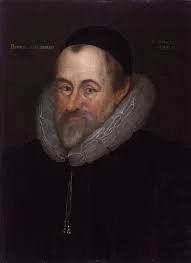 Jonson became friends with his teacher William Camden, whose scholarship influenced his literary style until Camden's death in 1623. At Westminster School, he also met the Welsh poet Hugh Holland, and they maintained a lasting friendship. Both later contributed poems to Shakespeare's First Folio.
Jonson became friends with his teacher William Camden, whose scholarship influenced his literary style until Camden's death in 1623. At Westminster School, he also met the Welsh poet Hugh Holland, and they maintained a lasting friendship. Both later contributed poems to Shakespeare's First Folio. -
 On leaving Westminster School in 1589, Jonson briefly attended St John's College, Cambridge, but returned home after a month due to his apprenticeship with his bricklayer stepfather. He later worked on building a garden wall in Lincoln's Inn and then went to the Netherlands to volunteer as a soldier with the English regiments of Sir Francis Vere in Flanders, fighting alongside the Dutch against Spain.
On leaving Westminster School in 1589, Jonson briefly attended St John's College, Cambridge, but returned home after a month due to his apprenticeship with his bricklayer stepfather. He later worked on building a garden wall in Lincoln's Inn and then went to the Netherlands to volunteer as a soldier with the English regiments of Sir Francis Vere in Flanders, fighting alongside the Dutch against Spain. -
 The Hawthornden Manuscripts report that while in Flanders, Jonson fought and killed an enemy soldier in single combat and took his weapons as trophies. Jonson is also said to have visited the antiquary Sir Robert Cotton in Chester early in the 17th century
The Hawthornden Manuscripts report that while in Flanders, Jonson fought and killed an enemy soldier in single combat and took his weapons as trophies. Jonson is also said to have visited the antiquary Sir Robert Cotton in Chester early in the 17th century -
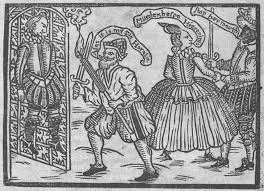 After his military service, Jonson returned to England and worked as an actor and playwright. He played the lead role of Hieronimo in Thomas Kyd's The Spanish Tragedy and, by 1597, was employed as a playwright by Philip Henslowe. The production of Every Man in His Humour in 1598 established his reputation as a dramatist.
After his military service, Jonson returned to England and worked as an actor and playwright. He played the lead role of Hieronimo in Thomas Kyd's The Spanish Tragedy and, by 1597, was employed as a playwright by Philip Henslowe. The production of Every Man in His Humour in 1598 established his reputation as a dramatist. -
 Shortly after his military service in the Netherlands, Ben Jonson met Anne Lewis.The two married around 1594, forming a partnership that would accompany Jonson as he transitioned from soldier to actor and playwright in England. While little is known about Anne’s life, their marriage marked an important personal milestone during a pivotal period in Jonson’s early adulthood. Ben Jonson married Anne Lewis in 1594 at the church of St Magnus-the-Martyr, near London Bridge.
Shortly after his military service in the Netherlands, Ben Jonson met Anne Lewis.The two married around 1594, forming a partnership that would accompany Jonson as he transitioned from soldier to actor and playwright in England. While little is known about Anne’s life, their marriage marked an important personal milestone during a pivotal period in Jonson’s early adulthood. Ben Jonson married Anne Lewis in 1594 at the church of St Magnus-the-Martyr, near London Bridge. -
 By summer 1597, Jonson had a fixed engagement in the Admiral's Men, then performed under Philip Henslowe's management at The Rose. John Aubrey reports, on uncertain authority, that Jonson was not successful as an actor; whatever his skills as an actor, he was more valuable to the company as a writer.By this time Jonson had begun to write original plays for the Admiral's Men.
By summer 1597, Jonson had a fixed engagement in the Admiral's Men, then performed under Philip Henslowe's management at The Rose. John Aubrey reports, on uncertain authority, that Jonson was not successful as an actor; whatever his skills as an actor, he was more valuable to the company as a writer.By this time Jonson had begun to write original plays for the Admiral's Men. -
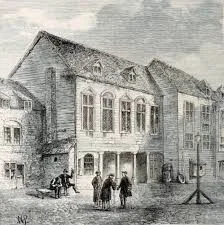 Jonson co-wrote The Isle of Dogs with Thomas Nashe, a play that was suppressed for causing offense. Jonson was jailed in Marshalsea Prison, while Nashe escaped, and two actors were also imprisoned. A year later, Jonson was briefly imprisoned in Newgate for killing actor Gabriel Spenser in a duel. He pleaded guilty to manslaughter but was released through the benefit of clergy, forfeiting his property and receiving a branding on his thumb.
Jonson co-wrote The Isle of Dogs with Thomas Nashe, a play that was suppressed for causing offense. Jonson was jailed in Marshalsea Prison, while Nashe escaped, and two actors were also imprisoned. A year later, Jonson was briefly imprisoned in Newgate for killing actor Gabriel Spenser in a duel. He pleaded guilty to manslaughter but was released through the benefit of clergy, forfeiting his property and receiving a branding on his thumb. -
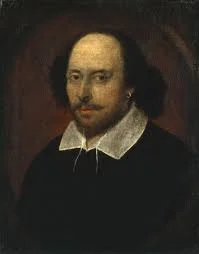 In 1598, Francis Meres mentioned Jonson in Palladis Tamia as one of "the best for tragedy," though none of his early tragedies survive. His undated comedy The Case is Altered may be his earliest surviving play. That same year, Jonson produced his first major success, Every Man in His Humour, following the trend for humorous plays begun by George Chapman, with William Shakespeare among the first actors cast.
In 1598, Francis Meres mentioned Jonson in Palladis Tamia as one of "the best for tragedy," though none of his early tragedies survive. His undated comedy The Case is Altered may be his earliest surviving play. That same year, Jonson produced his first major success, Every Man in His Humour, following the trend for humorous plays begun by George Chapman, with William Shakespeare among the first actors cast. -
 In 1599, Jonson followed up with Every Man out of His Humour, a play influenced by the style of Aristophanes. While it is unclear how successful the play was on stage, the published version proved popular and went through several editions, helping to establish Jonson’s reputation as a writer of witty and satirical comedy.
In 1599, Jonson followed up with Every Man out of His Humour, a play influenced by the style of Aristophanes. While it is unclear how successful the play was on stage, the published version proved popular and went through several editions, helping to establish Jonson’s reputation as a writer of witty and satirical comedy. -
 In the final years of Elizabeth I’s reign, Jonson’s work was marked by controversy. Cynthia's Revels (1600) satirized John Marston and Thomas Dekker, and Jonson targeted them again in Poetaster (1601). Dekker responded with Satiromastix, which caricatured a boastful poet resembling Jonson (who criticizes others and draws attention to himself, echoing descriptions of Jonson in William Drummond’s accounts).
In the final years of Elizabeth I’s reign, Jonson’s work was marked by controversy. Cynthia's Revels (1600) satirized John Marston and Thomas Dekker, and Jonson targeted them again in Poetaster (1601). Dekker responded with Satiromastix, which caricatured a boastful poet resembling Jonson (who criticizes others and draws attention to himself, echoing descriptions of Jonson in William Drummond’s accounts). -
 At the start of James I’s reign in 1603, Jonson joined other writers in welcoming the new king and quickly adapted to the demand for masques and entertainments favored by James and Queen Anne. In addition to his success on the public stage and at court, he enjoyed the patronage of aristocrats like Elizabeth Sidney and Lady Mary Wroth. His connection to the Sidney family inspired one of his most famous poems, To Penshurst.
At the start of James I’s reign in 1603, Jonson joined other writers in welcoming the new king and quickly adapted to the demand for masques and entertainments favored by James and Queen Anne. In addition to his success on the public stage and at court, he enjoyed the patronage of aristocrats like Elizabeth Sidney and Lady Mary Wroth. His connection to the Sidney family inspired one of his most famous poems, To Penshurst. -
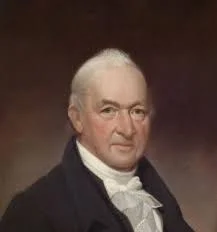 Jonson was reported to be living with Robert Townsend and scorns the world.he was questioned by the Privy Council about his play Sejanus, and later for another politically sensitive, now lost play. In October 1605, he attended a supper with some of the Gunpowder Plot conspirators. After the plot was uncovered, Jonson avoided imprisonment by volunteering information to Robert Cecil and the Privy Council, possibly using his connection with Father Thomas Wright, whom he had met in prison.
Jonson was reported to be living with Robert Townsend and scorns the world.he was questioned by the Privy Council about his play Sejanus, and later for another politically sensitive, now lost play. In October 1605, he attended a supper with some of the Gunpowder Plot conspirators. After the plot was uncovered, Jonson avoided imprisonment by volunteering information to Robert Cecil and the Privy Council, possibly using his connection with Father Thomas Wright, whom he had met in prison. -
 In 1603, Jonson’s eldest son, Benjamin, died of bubonic plague at the age of seven, inspiring Jonson to write the elegy On My First Sonne. A second son, also named Benjamin, died in 1635. For a period of five years, Jonson and his wife lived apart, during which he stayed with patrons such as Esme Stuart, Duke of Lennox, and Sir Robert Townshend.
In 1603, Jonson’s eldest son, Benjamin, died of bubonic plague at the age of seven, inspiring Jonson to write the elegy On My First Sonne. A second son, also named Benjamin, died in 1635. For a period of five years, Jonson and his wife lived apart, during which he stayed with patrons such as Esme Stuart, Duke of Lennox, and Sir Robert Townshend.